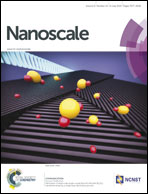Molecular resolution friction microscopy of Cu phthalocyanine thin films on dolomite (104) in water
Abstract
The reliability of ultrathin organic layers as active components for molecular electronic devices depends ultimately on an accurate characterization of the layer morphology and ability to withstand mechanical stresses on the nanoscale. To this end, since the molecular layers need to be electrically decoupled using thick insulating substrates, the use of AFM becomes mandatory. Here, we show how friction force microscopy (FFM) in water allows us to identify the orientation of copper(II)phthalocyanine (CuPc) molecules previously self-assembled on a dolomite (104) mineral surface in ultra-high vacuum. The molecular features observed in the friction images show that the CuPc molecules are stacked in parallel rows with no preferential orientation with respect to the dolomite lattice, while the stacking features resemble well the single CuPc crystal structure. This proves that the substrate induction is low and makes friction force microscopy in water a suitable alternative to more demanding dynamic AFM techniques in ultra-high vacuum.


 Please wait while we load your content...
Please wait while we load your content...